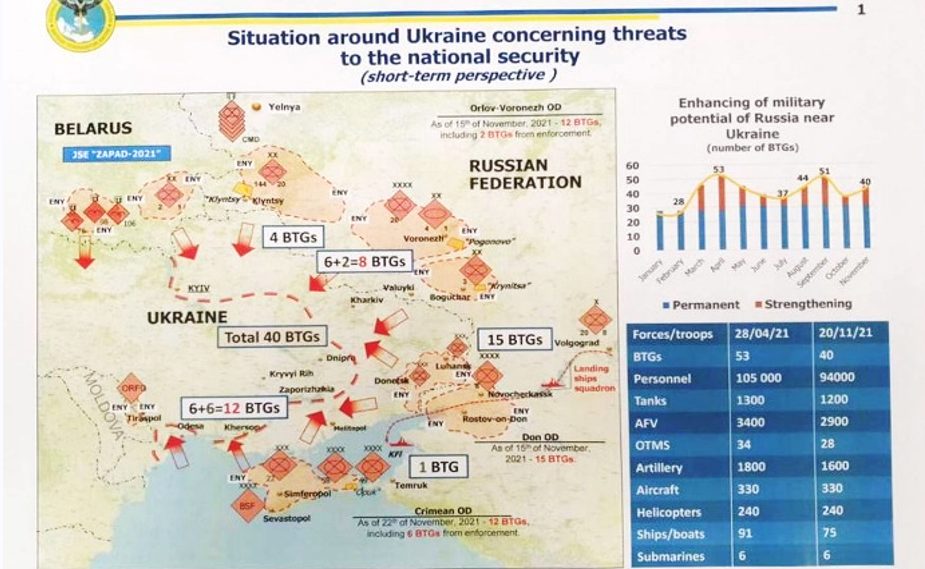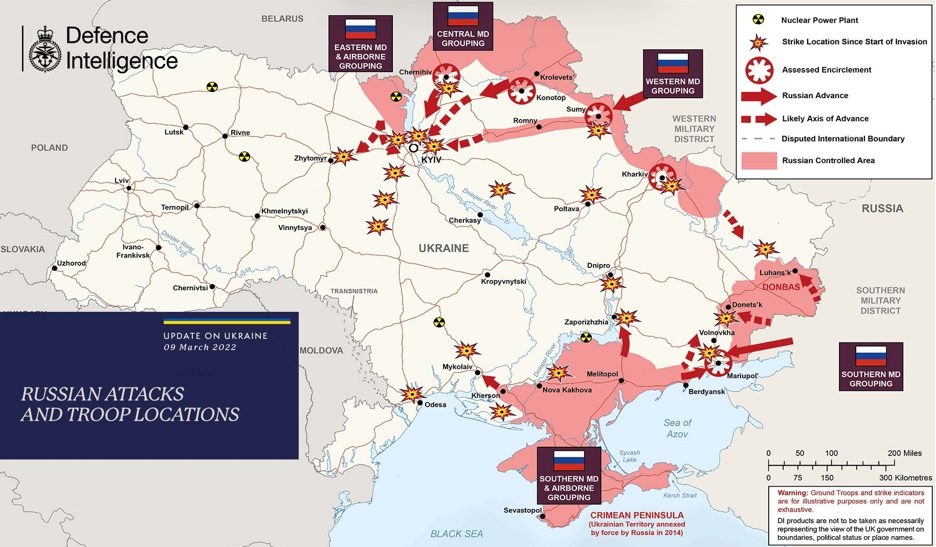Publications
INSS Insight No. 1577, March 27, 2022
The war in Ukraine marks a new climax in the public use of intelligence by states. The United States, the UK, and even the government of Ukraine have revealed intelligence information and assessments about Russia’s intentions and plans before and during the invasion. On the political level, the revelations contributed to shape a narrative that clearly marked Putin as an aggressor and Ukraine as a victim, and thus contributed to the consolidation of a strong and unified front against Russia. On the strategic level, the early revelation of Russian intentions did not deter the Kremlin. At the same time, on the tactical level, exposing the Russian plans, with an emphasis on covert operations, apparently prompted their cancellation and contributed to the undermining of Russian confidence, which may have an impact on the course of the war. While the public use of intelligence is not foreign to Israel, the case of Ukraine emphasizes several important lessons: the revelation of intelligence is limited in its ability to prevent a determined adversary from working to achieve objectives, though it may disrupt and delay plans and moves. Above all, disclosure helps to influence the agenda and shape domestic and international public opinion.
Intelligence is intended first and foremost to help decision makers. Its role is to provide them with quality information that enables them to formulate policy vis-à-vis situational changes, and to guide the operational bodies on how to prepare for these changes to maintain political, economic, and military advantages. However, in recent years, thanks to the dramatic changes in the information and media environment and the rise in the importance and influence of social media and world public opinion on politics and on war in particular, intelligence itself becomes a tool for implementing policy and influencing reality.
The crisis surrounding Ukraine reflects one of the climaxes of this trend. In the months that preceded the Russian invasion and since it began, the public use of intelligence has become a central tool in the hands of the West and in the hands of the Ukrainian government itself for managing the crisis. Senior American officials, as quoted in the New York Times, have defined the administration's intelligence revelation campaign as the most aggressive since the Cuban Missile Crisis in 1962.
The campaign began in November 2021 with Ukrainian warnings about the deployment of Russian army forces beyond Ukraine's eastern border. The Americans and Ukrainians gradually started to update publicly the order of battle that Russia amassed around Ukraine, which at that stage was under 100,000 soldiers. Ukrainian military intelligence was also the first to reveal a map that noted possible directions from which the attack against Ukraine would be launched. In early December, a similar map appeared in the Washington Post, alongside an American intelligence community assessment that President Vladimir Putin was planning to station up to 175,000 soldiers and invade Ukraine in early 2022. In January, the White House Press Secretary stated that there were indications that Russia was planning to stage a false flag operation that would look like an attack against Russian-speaking Ukrainian citizens in the country's east as a pretext for launching a war. At the end of that month, the British Foreign Office shared information with the public that Russian intelligence was preparing to establish a puppet regime in Kiev after defeating Ukraine.

Slide published by Ukrainian military intelligence in Military Times, November 21, 2021
By early February, the Russians had already amassed about 140,000 soldiers on the front. On February 13, eleven days before the Russian army entered Ukrainian territory, a senior American official, who remained anonymous, estimated that Putin would give the order on Wednesday, February 16. When that day passed without the intelligence warning realized, the Russians – who had emphatically denied all Western intelligence claims and dismissed them as anti-Russian hysteria – announced the withdrawal of forces from the Ukrainian front. However, American and British intelligence quickly refuted the Russian claims and stated that the amassing of Russian forces continued, having reached 150,000 soldiers. On February 23, one day before the invasion, it was reported that the United States had conveyed a warning to President Volodymyr Zelensky of an invasion of his country within 48 hours.
When the Russian attack began early in the morning on February 24, the Western media was quick to declare a tremendous intelligence success. However, aside from the prediction that was realized, what was the role of intelligence in the crisis, and what was the actual contribution of the public use of information? This perhaps might never be known, but there are several insights that can be noted in these contexts.
On the political level, the constant intelligence assessments helped form a coherent narrative that painted Putin as an aggressor. The information showed a clear picture of a leader determined to take over Ukraine by force, while all the diplomatic, media, and military actions that originated in the Kremlin aimed to cloud the picture in the eyes of the world and in the eyes of the Ukrainians. The narrative drew a clear line between good and bad and between right and wrong, and thus enabled the West to form a broad and uniform front quickly against Russia. This translated into strengthening the European security community, with an emphasis on the NATO alliance, and imposing painful sanctions on Russia, which in tandem demanded difficult concessions from the Western economy. This seems to be one of the biggest achievements of the West in the current crisis – one that to a large extent surprised the international community and first and foremost the Russians themselves.
On the strategic level, publicly disclosing the intelligence on Russia's intentions and plans failed to create deterrence and prevent the invasion. However, this was apparently not the West's aim. On the contrary, the public use of intelligence is a default that indicates the West's unwillingness to commit to deterring Russia, which would include a willingness to use military force and incur a risk of war. Indeed, if the West were determined to defend Ukraine with military force, it would have acted more cautiously with regard to the intelligence and refrained from risking essential sources in order to maintain superiority in the case that it would have been necessary to use this force against Russia.
Furthermore, some have claimed that the public discussion of Putin's intentions pushed him into a corner and didn't leave him a choice but to carry out the offensive intentions attributed to him. This claim is problematic. On the one hand, if we assume that Putin used coercive diplomacy, meaning he sought to create a credible military threat in order to extract political and military achievements, then the publicized intelligence assessments, which attributed great credibility to the threat, granted the global reverberation that Putin could have leveraged had he evinced a willingness for compromise and de-escalation. On the other hand, if from the outset Putin was determined to invade Ukraine, as the Western intelligence claimed, then concern for international image and legitimacy or tactical military considerations was not his top priority, and therefore the revelation alone could not have stopped him, although in this case it may have accelerated the launching of the campaign.
On the tactical level, intelligence disclosure helped undermine Russian confidence and disrupt Russia's military and information operations, and at the same time bought time for Ukraine. Knowing that the government and military leadership have been infiltrated is unsettling, all the more so right before launching a military operation. The public disclosures presumably led to directing attention toward investigating and closing the intelligence breaches, and created cracks of distrust in the Russian leadership, which perhaps harmed and continues to harm the communication between echelons and bodies in Russia and erodes its operational effectiveness in the war. The reports on the arrest of senior Russian intelligence officials could be an indication of this. Concretely, revealing the secret operations to create a pretext for launching the war and replacing the government in Kiev seems to have pulled the rug out from under them and caused their cancellation, or at least changes. In addition, from the moment Putin made his decision to invade Ukraine, his main effort in the information arena was to "put the Ukrainians to sleep" with ruse and deception in order to mitigate the military resistance. The Western revelations made this much more difficult.
Joining this is the daily publication of assessments and information during the war from the intelligence communities of the United States and the UK. These reports address the need to cope with misinformation and disinformation, intentional and unintentional, on the part of both Russia and Ukraine, and reflect a balanced picture of the state of the fighting and its consequences in a way that enables level-headed and calculated decision making. For example, when Ukrainian sources reported Russian actions that threaten nuclear facilities at Chernobyl and Zaporizhzhia, Western and international bodies were quick to correct the reports in a way that so far has moderated the initial impression. However, beyond presenting an objective picture of the fighting, these reports also involve identification with the Ukrainian side and have an interest in harming the image of Russian strength and the army's morale. Thus, the picture that arises from the reports, which in the eyes of many Western observers does not flatter the superior Russian army, could actually negatively affect the chances of stopping the campaign. This is because it would take a clear military achievement – besieging and conquering Kiev or cutting Ukraine off from access to the sea – to ensure that Russia's powerful image and deterrent capability are not damaged.

Map showing state of the fighting in Ukraine that is published each day on the British Ministry of Defence Twitter account
Intelligence disclosure as a foreign policy tool is not new to world history, and certainly not to Israel. In the past decade, Israel has systematically revealed intelligence for a variety of diplomatic and military purposes, from the effort to enlist the international community in placing pressure on Iran to abandon its nuclear program, to thwarting attacks from the Gaza Strip and undermining the military buildup plans of Iran and Hezbollah.
Israel’s experience invites similar conclusions to those that emerge from the crisis in Ukraine: revealing intelligence is limited in its ability to cope with a determined adversary and prevent it from working to achieve a high-priority objective. Sometimes, it even pushes the adversary to display greater determination vis-à-vis domestic and external audiences. However, it can cause particular disruptions and delays that stem from rendering plans, methods of operation, personalities, and places unusable, which forces the adversary to make adjustments and close breaches. But it seems that the greatest benefit from the public use of intelligence is in influencing the agenda and shaping domestic and foreign public opinion. As with Israel's struggle against Iran and its proxies in the Middle East, so in Ukraine and the West's struggle against Russia, the revelation of the adversary's intentions and offensive plans helps create a sympathetic narrative, garner support, and recruit legitimacy for painful but sometimes necessary actions in coping with the threats.
At the same time, public disclosure of intelligence involves significant risk to sources and methods. Sometimes the sources are based on technology, and publishing the information attained through them could lead to their discovery and removal, and later also to closure of the technological gap between the discloser and the disclosed. Sometimes they are human sources with access to limited decision making circles, so that exposing pieces of information based on their reports could easily lead to their discovery, and of course harm to their personal security. A reputation of revealing information and endangering sources can even lead to difficulty recruiting human sources in the future.
The case study of public use of intelligence surrounding the crisis in Ukraine, alongside the cumulative conclusions from Israel’s experience, offers perspective and clarifies the advantages and disadvantages, and the costs and benefits, of applying this practice, which is gaining traction in international relations.
______________________
* Ofek Riemer is a PhD candidate in international relations at the Hebrew University of Jerusalem. His doctoral thesis deals with the public disclosure of intelligence as a foreign policy tool.



